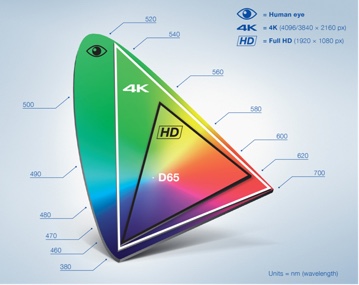Time and technology marches on
…and into the OR

Remember the big transition from standard-definition to high-definition TVs? If you’re thinking that was over a decade ago (1998, actually), you’d be right. And if you’re remembering it was a royal pain in the rump, you’d also be right—those different aspect ratios, groan!
But, it’s high time for the newest evolution in imaging, and this time it’s not going to be painful at all. Enter 4K, or ultra high definition (UHD). If it hasn’t walked through the door of your healthcare facility yet, it’s going to. It is already transforming the consumer space. And in the surgical arena, the old HD technology that was just fine a decade ago won’t be fine tomorrow.
If you’re saying wait, hold the phone—and no doubt that’s a smartphone you’re holding—that’s a good place to start to put this all in context. If you happen to own the newest generation iPhone or its ilk, you’re probably already using UHD during video capture.
“In 2015/2016, 4K video recording has gone from being a deeply exotic feature to something that pretty much every truly high-end flagship smartphone from a name brand ‘must have’.” – Reviews and Information on the Latest 4k Smartphones and UHD Cameras. 4K.com (Nov. 22, 2016).
And as interest and demand for 4K TV sets continue to increase, so too has commercially produced 4K content. According to Ryan Waniata and Kris Wouk, Digital Trends (Oct. 13, 2016), “The good news is the 4K Ultra HD content pipeline has transitioned from a trickle to a steady flow, and in the next couple of years, it’s going to be more like a rushing river.”
So with you and your hospital’s surgical teams viewing and consuming entertainment using the most advanced imaging technology, it’s a good bet that HD is going to start looking pretty darn dull and archaic pretty fast in the surgical suite.
But more importantly, beyond its visual eye-candy appeal, 4K can have two significant impacts on your facility’s operations as well:

When your surgical teams can see the target site in finer detail, they can operate with more precision, further pushing the boundaries of surgical intervention. Any surgery that involves a laparoscope can benefit dramatically from an upgrade to 4K. It offers four times the resolution of conventional HD and twice the color range. The result is more subtle differences in reds and yellows, which can make a difference in detecting anomalies and improving surgical outcomes.

Each generation of technological advances tends to nudge out the one before it. In imaging, we went from black and white to standard definition to high definition. Now we’re seeing the transition from HD to UHD (4K). Certainly, HD imaging has had a good run as the gold standard. One could even argue it still makes some sense in smaller displays where the human eye can’t detect the difference between HD and UHD. But in the surgical arena—where even the smallest detail can make the biggest difference—it’s high time to say adieu to HD. It’s time to make way for 4K and the next generation of jaw-dropping imaging excellence.
Technology marches on and with it, surgical advances. Our choice is whether we want to be leading the charge or hanging on to the back of the pack, hoping to not get dropped in the process. So, what are you waiting for?
Want to know more about 4K trends in the surgical space? Get linked to upcoming articles by signing up for our email notifications below.


































